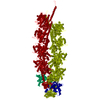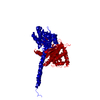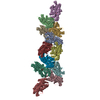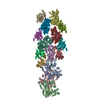+ Open data
Open data
- Basic information
Basic information
| Entry | Database: PDB / ID: 3j4t | ||||||
|---|---|---|---|---|---|---|---|
| Title | Helical model of TubZ-Bt two-stranded filament | ||||||
 Components Components | FtsZ/tubulin-related protein | ||||||
 Keywords Keywords | STRUCTURAL PROTEIN / TubZ / FtsZ-like / tubulin-like / plasmid segregation | ||||||
| Function / homology |  Function and homology information Function and homology informationplasmid partitioning / Hydrolases; Acting on acid anhydrides; Acting on GTP to facilitate cellular and subcellular movement / GTPase activity / GTP binding / metal ion binding / identical protein binding / cytoplasm Similarity search - Function | ||||||
| Biological species |  | ||||||
| Method | ELECTRON MICROSCOPY / helical reconstruction / cryo EM / Resolution: 10.8 Å | ||||||
 Authors Authors | Agard, D.A. / Montabana, E.A. | ||||||
 Citation Citation |  Journal: Proc Natl Acad Sci U S A / Year: 2014 Journal: Proc Natl Acad Sci U S A / Year: 2014Title: Bacterial tubulin TubZ-Bt transitions between a two-stranded intermediate and a four-stranded filament upon GTP hydrolysis. Authors: Elizabeth A Montabana / David A Agard /  Abstract: Cytoskeletal filaments form diverse superstructures that are highly adapted for specific functions. The recently discovered TubZ subfamily of tubulins is involved in type III plasmid partitioning ...Cytoskeletal filaments form diverse superstructures that are highly adapted for specific functions. The recently discovered TubZ subfamily of tubulins is involved in type III plasmid partitioning systems, facilitating faithful segregation of low copy-number plasmids during bacterial cell division. One such protein, TubZ-Bt, is found on the large pBtoxis plasmid in Bacillus thuringiensis, and interacts via its extended C terminus with a DNA adaptor protein TubR. Here, we use cryo-electron microscopy to determine the structure of TubZ-Bt filaments and light scattering to explore their mechanism of polymerization. Surprisingly, we find that the helical filament architecture is remarkably sensitive to nucleotide state, changing from two-stranded to four-stranded depending on the ability of TubZ-Bt to hydrolyze GTP. We present pseudoatomic models of both the two- and four-protofilament forms based on cryo-electron microscopy reconstructions (10.8 Å and 6.9 Å, respectively) of filaments formed under different nucleotide states. These data lead to a model in which the two-stranded filament is a necessary intermediate along the pathway to formation of the four-stranded filament. Such nucleotide-directed structural polymorphism is to our knowledge an unprecedented mechanism for the formation of polar filaments. #1:  Journal: Proc Natl Acad Sci U S A / Year: 2010 Journal: Proc Natl Acad Sci U S A / Year: 2010Title: Filament structure of bacterial tubulin homologue TubZ. Authors: Christopher H S Aylett / Qing Wang / Katharine A Michie / Linda A Amos / Jan Löwe /  Abstract: Low copy number plasmids often depend on accurate partitioning systems for their continued survival. Generally, such systems consist of a centromere-like region of DNA, a DNA-binding adaptor, and a ...Low copy number plasmids often depend on accurate partitioning systems for their continued survival. Generally, such systems consist of a centromere-like region of DNA, a DNA-binding adaptor, and a polymerizing cytomotive filament. Together these components drive newly replicated plasmids to opposite ends of the dividing cell. The Bacillus thuringiensis plasmid pBToxis relies on a filament of the tubulin/FtsZ-like protein TubZ for its segregation. By combining crystallography and electron microscopy, we have determined the structure of this filament. We explain how GTP hydrolysis weakens the subunit-subunit contact and also shed light on the partitioning of the plasmid-adaptor complex. The double helical superstructure of TubZ filaments is unusual for tubulin-like proteins. Filaments of ParM, the actin-like partitioning protein, are also double helical. We suggest that convergent evolution shapes these different types of cytomotive filaments toward a general mechanism for plasmid separation. | ||||||
| History |
|
- Structure visualization
Structure visualization
| Movie |
 Movie viewer Movie viewer |
|---|---|
| Structure viewer | Molecule:  Molmil Molmil Jmol/JSmol Jmol/JSmol |
- Downloads & links
Downloads & links
- Download
Download
| PDBx/mmCIF format |  3j4t.cif.gz 3j4t.cif.gz | 93.8 KB | Display |  PDBx/mmCIF format PDBx/mmCIF format |
|---|---|---|---|---|
| PDB format |  pdb3j4t.ent.gz pdb3j4t.ent.gz | 69.6 KB | Display |  PDB format PDB format |
| PDBx/mmJSON format |  3j4t.json.gz 3j4t.json.gz | Tree view |  PDBx/mmJSON format PDBx/mmJSON format | |
| Others |  Other downloads Other downloads |
-Validation report
| Summary document |  3j4t_validation.pdf.gz 3j4t_validation.pdf.gz | 766.6 KB | Display |  wwPDB validaton report wwPDB validaton report |
|---|---|---|---|---|
| Full document |  3j4t_full_validation.pdf.gz 3j4t_full_validation.pdf.gz | 773.3 KB | Display | |
| Data in XML |  3j4t_validation.xml.gz 3j4t_validation.xml.gz | 18.6 KB | Display | |
| Data in CIF |  3j4t_validation.cif.gz 3j4t_validation.cif.gz | 26 KB | Display | |
| Arichive directory |  https://data.pdbj.org/pub/pdb/validation_reports/j4/3j4t https://data.pdbj.org/pub/pdb/validation_reports/j4/3j4t ftp://data.pdbj.org/pub/pdb/validation_reports/j4/3j4t ftp://data.pdbj.org/pub/pdb/validation_reports/j4/3j4t | HTTPS FTP |
-Related structure data
| Related structure data |  5763MC  5762C  3j4sC M: map data used to model this data C: citing same article ( |
|---|---|
| Similar structure data |
- Links
Links
- Assembly
Assembly
| Deposited unit | 
|
|---|---|
| 1 | x 10
|
| 2 |
|
| 3 | 
|
| Symmetry | Helical symmetry: (Circular symmetry: 1 / Dyad axis: no / N subunits divisor: 1 / Num. of operations: 10 / Rise per n subunits: 22.048 Å / Rotation per n subunits: -168.158 °) |
- Components
Components
| #1: Protein | Mass: 55052.438 Da / Num. of mol.: 1 Source method: isolated from a genetically manipulated source Source: (gene. exp.)   |
|---|---|
| Sequence details | MUTATION L2V IS INHERITED FROM PDB ENTRY 2XKA. THE SAMPLE IMAGED FOR THIS ENTRY CONTAINS NO MUTATIONS. |
-Experimental details
-Experiment
| Experiment | Method: ELECTRON MICROSCOPY |
|---|---|
| EM experiment | Aggregation state: FILAMENT / 3D reconstruction method: helical reconstruction |
- Sample preparation
Sample preparation
| Component | Name: TubZ-Bt / Type: COMPLEX |
|---|---|
| Buffer solution | Name: HMK100 / pH: 7.7 Details: 100 mM potassium acetate, 5 mM magnesium acetate, 50 mM HEPES |
| Specimen | Embedding applied: NO / Shadowing applied: NO / Staining applied: NO / Vitrification applied: YES |
| Specimen support | Details: 400 mesh copper grid with holey carbon support, glow discharged |
| Vitrification | Instrument: FEI VITROBOT MARK III / Cryogen name: ETHANE / Humidity: 100 % Details: TubZ was preheated at 37 degrees and polymerization was initiated with saturating GTPgammaS. TubZ was then incubated for 30 seconds at room temperature before sample application, 4.5 second ...Details: TubZ was preheated at 37 degrees and polymerization was initiated with saturating GTPgammaS. TubZ was then incubated for 30 seconds at room temperature before sample application, 4.5 second blotting, and plunge-freezing into liquid ethane (FEI VITROBOT MARK III). Method: Blot 4.5 s before plunging |
- Electron microscopy imaging
Electron microscopy imaging
| Experimental equipment |  Model: Tecnai F20 / Image courtesy: FEI Company |
|---|---|
| Microscopy | Model: FEI TECNAI F20 / Date: May 26, 2010 |
| Electron gun | Electron source:  FIELD EMISSION GUN / Accelerating voltage: 200 kV / Illumination mode: FLOOD BEAM FIELD EMISSION GUN / Accelerating voltage: 200 kV / Illumination mode: FLOOD BEAM |
| Electron lens | Mode: BRIGHT FIELD / Nominal magnification: 62000 X / Nominal defocus max: 4500 nm / Nominal defocus min: 1500 nm / Cs: 2.2 mm |
| Specimen holder | Specimen holder model: OTHER / Specimen holder type: Oxford side-entry cryo stage |
| Image recording | Electron dose: 20 e/Å2 / Film or detector model: TVIPS TEMCAM-F816 (8k x 8k) / Details: 8k x 8k |
| Image scans | Num. digital images: 348 |
- Processing
Processing
| EM software |
| ||||||||||||
|---|---|---|---|---|---|---|---|---|---|---|---|---|---|
| CTF correction | Details: Whole Micrograph | ||||||||||||
| Helical symmerty | Angular rotation/subunit: -168.15849 ° / Axial rise/subunit: 22.04811 Å / Axial symmetry: C1 | ||||||||||||
| 3D reconstruction | Method: Iterative Helical Real Space Refinement / Resolution: 10.8 Å / Resolution method: FSC 0.143 CUT-OFF / Actual pixel size: 1.203 Å Details: Final map has been low-pass filtered to 11 Angstrom and high-pass filtered to 35 Angstrom. A B-factor of -452 Angstrom was applied using the program bfactor. A cylindrical mask of radius ~78 ...Details: Final map has been low-pass filtered to 11 Angstrom and high-pass filtered to 35 Angstrom. A B-factor of -452 Angstrom was applied using the program bfactor. A cylindrical mask of radius ~78 Angstrom has been applied. Symmetry type: HELICAL | ||||||||||||
| Atomic model building | Protocol: OTHER / Space: REAL Details: METHOD--Chimera DETAILS--Just local fitting done with Chimera | ||||||||||||
| Atomic model building | PDB-ID: 2XKA Pdb chain-ID: F / Accession code: 2XKA / Source name: PDB / Type: experimental model | ||||||||||||
| Refinement step | Cycle: LAST
|
 Movie
Movie Controller
Controller












 PDBj
PDBj


